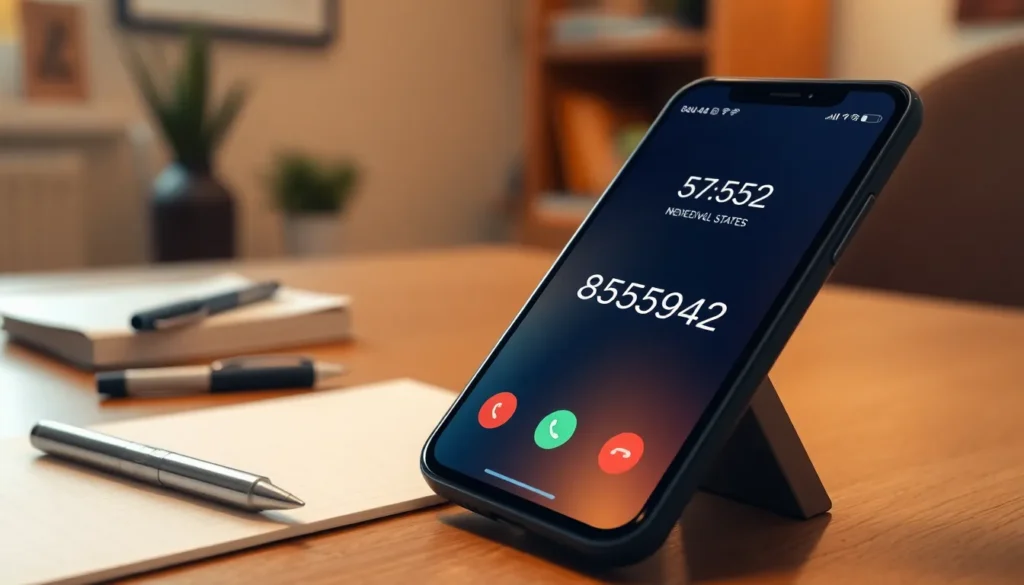Table of Contents
ToggleIn today’s fast-paced work environment, internal communication can feel like herding cats—chaotic and often unproductive. Enter internal communication mobile apps, the superheroes of workplace connectivity. These nifty tools swoop in to save the day, ensuring teams stay in sync, no matter where they are.
Imagine a world where messages don’t get lost in the abyss of email or buried under a mountain of paperwork. With the right app, employees can chat, share files, and collaborate seamlessly, all from the palm of their hand. It’s like having a virtual water cooler that fits in your pocket! As businesses evolve, embracing these apps isn’t just a smart move; it’s essential for fostering a vibrant, engaged workforce. So, let’s dive into how these mobile marvels can transform internal communication from a clumsy dance into a smooth waltz.
Overview of Internal Communication Mobile Apps
Internal communication mobile apps serve as vital tools that bridge gaps within organizations. These applications empower employees to connect in real time, fostering engagement and collaboration. By enabling chat functionalities, users can exchange messages instantly, enhancing responsiveness and team dynamics.
File sharing features streamline the distribution of documents, making resources readily accessible from any location. They support integration with various platforms, allowing users to connect existing tools like calendars and project management systems. Notifications keep teams informed of updates, ensuring everyone stays aligned on projects and deadlines.
Analytics features within these apps provide insights into communication patterns and effectiveness. Managers can evaluate engagement levels and identify areas that need improvement. Customization options enable organizations to tailor the app experience according to their specific needs and culture.
Security measures, such as encryption and user authentication, protect sensitive information, ensuring that only authorized personnel access specific content. These protocols enhance overall trust and reliability in communication practices.
Examples of popular internal communication mobile apps include Slack, Microsoft Teams, and Zoom. Each app offers unique functionalities that cater to various organizational requirements. The widespread adoption of these tools highlights their role in promoting efficient communication and collaboration across industries.
Through the integration of internal communication mobile apps, organizations can transform their communication landscape, leading to improved workflows and stronger team connections.
Key Features of Effective Internal Communication Mobile Apps

Effective internal communication mobile apps enhance workplace engagement through various key features that promote connectivity and collaboration.
User-Friendly Interface
A user-friendly interface simplifies navigation for employees across all skill levels. Clean layouts and intuitive design enhance accessibility, encouraging frequent use. Icons and easy-to-read text enable quick comprehension of features. Customizable settings allow organizations to adapt the interface to their branding, fostering a sense of ownership. An interactive experience can lead to higher engagement rates and better communication outcomes.
Real-Time Messaging
Real-time messaging facilitates instant communication among team members, reducing response times. Immediate access to chat functions ensures that employees can address questions or concerns swiftly. Notifications alert users to new messages, keeping conversations active. Group chats and direct messaging options promote collaborative discussions. This feature cultivates a dynamic work environment, enhancing team cohesion and maintaining momentum on projects.
File Sharing Capabilities
File sharing capabilities streamline document exchange within teams. Quick uploads and downloads allow for seamless access to important files, increasing productivity. Collaboration tools often feature integrated editing options, enabling teams to work on documents simultaneously. Organized storage options facilitate easy retrieval of shared resources. Enhanced security measures protect sensitive files, instilling confidence that information remains secure across communications.
Popular Internal Communication Mobile Apps
Many organizations leverage mobile apps to enhance internal communication. These apps streamline employee interactions and boost engagement across teams.
App 1: Features and Benefits
Slack offers robust messaging features that facilitate real-time communication among teams. Users benefit from organized channels that segregate discussions by topics or projects, ensuring clarity. File sharing options simplify document collaboration, allowing quick access and edits. Notifications keep users updated, promoting timely responses. Plus, third-party integrations with tools like Google Drive and Trello enhance connectivity and workflow efficiency. Security measures include enterprise-grade encryption, ensuring data protection.
App 2: Features and Benefits
Microsoft Teams provides a comprehensive platform for chat, video conferencing, and file sharing. Collaborative spaces shape discussions, with users enjoying the ability to host video calls directly from the app. Document collaboration occurs seamlessly within shared channels, allowing multiple users to edit in real time. Integration with Office 365 tools boosts productivity, while calendar synchronization keeps teams aligned on schedules. Advanced security options, such as multifactor authentication, safeguard sensitive information, fostering confidence in communication.
App 3: Features and Benefits
Zoom excels in video communication, making it ideal for remote teams. High-quality video calls offer a reliable solution for virtual meetings and webinars. Users appreciate features like breakout rooms for small group discussions, enhancing collaboration. Integration with various productivity tools helps maintain organized workflows. Recording capabilities allow teams to revisit important discussions, ensuring nothing is overlooked. Security protocols, including encryption and password protection, enhance user trust and data safety.
Challenges in Implementing Internal Communication Mobile Apps
Implementing internal communication mobile apps poses several challenges. Security concerns rank high among these issues, as organizations worry about protecting sensitive information. Data breaches can lead to significant consequences, prompting the need for robust security measures.
Integration with existing systems proves problematic for many businesses. Compatibility issues may arise, creating friction between various tools and platforms. Employees often encounter difficulties when multiple applications fail to work seamlessly together.
User adoption can also present a challenge. Employees might resist change, preferring existing communication methods over learning new software. The effectiveness of these apps hinges on users embracing them, leading to a lack of engagement.
Performance issues can arise due to inadequate infrastructure. Poor connectivity or outdated devices can lead to frustrating experiences for users. Downtime or slow response times diminish the overall utility of the apps.
Customization presents another hurdle. While tailored experiences enhance usability, they require substantial time and resources to implement properly. Organizations often struggle to balance personalization with the need for a standardized approach.
Training employees on new technologies remains essential. Comprehensive onboarding programs can mitigate confusion and boost confidence in using the apps. However, these programs demand investment in time and resources, which can strain budgets.
Feedback and continuous improvement pose additional challenges. Organizations must establish effective channels for users to share their experiences promptly. Failure to act on feedback can result in ongoing issues and decreased morale.
Implementing internal communication mobile apps necessitates addressing security, integration, user adoption, performance, customization, training, and feedback challenges. Organizations need strategies to overcome these barriers to enhance communication within their workforce.
Embracing internal communication mobile apps is essential for organizations striving to enhance connectivity and engagement among their teams. These applications not only streamline communication but also empower employees to collaborate effectively in real time. By addressing common challenges such as security and user adoption, companies can transform their communication landscape and foster a more cohesive work environment.
As technology continues to evolve, investing in the right tools will be crucial for maintaining a competitive edge. Organizations that prioritize effective communication through mobile apps are likely to see improved workflows and stronger team dynamics, ultimately leading to greater organizational success.




